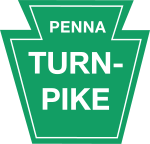Pennsylvania Turnpike/Interstate 95 Interchange Project
| Pennsylvania Turnpike/Interstate 95 Interchange Project | |
|---|---|
_to_future_Interstate_95_(Pennsylvania_Turnpike%2C_currently_Interstate_276)_in_Bristol_Township%2C_Pennsylvania.jpg) Ramp piers for the interchange under construction in 2016 | |
| Location | |
| Bristol Township, Bucks County, Pennsylvania | |
| Coordinates: | 40°07′44″N 74°53′23″W / 40.128875°N 74.889727°WCoordinates: 40°07′44″N 74°53′23″W / 40.128875°N 74.889727°W |
| Roads at junction: |
|
| Construction | |
| Constructed: | 2010–2018 |
| Opened: | After 2018 |
| Maintained by: | PennDOT |
| Map | |
 | |
The Pennsylvania Turnpike/Interstate 95 Interchange Project is a project in the United States to build an interchange where Interstate 95 (I-95) crosses the Pennsylvania Turnpike in Bristol Township, Bucks County, Pennsylvania. This will fill the gap that exists on I-95 through New Jersey due to the cancellation of the Somerset Freeway. The project includes widening the Turnpike east of U.S. Route 1 (US 1) and rebuilding the Delaware River–Turnpike Toll Bridge, which connects Bristol Township with Burlington Township, New Jersey. It also includes extending Interstate 295 from its current northern terminus at U.S. Route 1 in Lawrence Township, New Jersey to the proposed interchange.
Construction began in November 2010 and will cost approximately $650 million. When completed, this will allow I-95 to be a continuous route between Philadelphia and New York City and finally complete the highway from Miami, Florida to the Houlton–Woodstock Border Crossing in Maine. The project is the last in the country to be financed under the Federal-Aid Highway Act of 1956, which established the Interstate Highway System.[1] It is also the first transportation project in Pennsylvania to be funded through the EB-5 visa program, with the Pennsylvania Turnpike Commission considering it for the unfinished Mon–Fayette Expressway and Southern Beltway projects near Pittsburgh depending on the results of the Turnpike/I-95 Project.[2]
History
As far back as the formation of the Interstate Highway System, I-95 was planned as a Florida-to-Maine superhighway. The highway was also intended to pass through the Northeast Megalopolis. However, decades of disputes among local and regional governments and private landowners prevented or delayed the design and construction of this highway from the Trenton–Philadelphia area to northern New Jersey in the New Brunswick–Piscataway area. To this day, I-95 is incomplete because of the gap in this area. Specifically, if drivers wish to proceed northbound from Newark, Delaware, to New York City without encountering a traffic signal, the most direct route today is to exit I-95 onto I-295 just south of Wilmington, enter New Jersey via the Delaware Memorial Bridge, and continue north on the New Jersey Turnpike. Alternatively, if drivers stayed on I-95 north, they would pass through Delaware County, Pennsylvania, the city of Philadelphia, and Bucks County, Pennsylvania and then over the Delaware River into Mercer County, New Jersey northwest of Trenton. At this point, I-95 abruptly ends at the interchange of US 1 in Lawrence Township and becomes I-295 south. Motorists then enter I-195 eastbound from I-295 exit 60A, and then take I-195 to the New Jersey Turnpike northbound (where I-95 continues). According to the New Jersey Turnpike Authority, the turnpike is signed as I-95 in the area of Robbinsville Township north of Turnpike exit 7A (for I-195). However, NJDOT states that I-95 starts from the New Jersey – Pennsylvania Turnpike Connector Bridge and follows the New Jersey Turnpike Extension to the northbound lanes of the mainline of the turnpike.
Earliest designs
During the mid-1950s, while I-95 was still in its infancy, a proposal was made to route it through the city of Trenton by way of the Trenton Toll Bridge (now in use and designated to US 1).[3] New Jersey opposed this routing due to the limited capacity of that bridge. A proposal to bypass and loop around Trenton was formally proposed and agreed upon by both states in the late 1950s. What was eventually called the Scudder Falls Bridge was constructed in 1959. Completed soon afterward was a section of I-95 north of Trenton. Plans then began in the mid-1960s to join this segment to I-287 in northern New Jersey. This controversial section of I-95 became known as the Somerset Freeway, but by 1978, doubts were expressed that I-95 would ever be completed.[4]
Somerset Freeway
The Somerset Freeway was planned to run from existing I-95 in Hopewell Township northeast to I-287 in Piscataway Township, where I-95 would have followed I-287 east to the New Jersey Turnpike. The project was cancelled in 1983, primarily for two reasons. First, residents along the Princeton corridor feared increased congestion and a drop in property values. Second, the state of New Jersey feared a drop in state revenues by diverting traffic from the New Jersey Turnpike. A 1980 article in The New York Times stated:
Killing I-95 means that the entire length of the turnpike almost surely will become the official I-95 artery through the state, thus assuring it a continued source of toll revenue. At present, only that segment of the turnpike north of exit 10 in Middlesex County is designated as I-95.[5]
As a result, I-95 was later rerouted south on the turnpike to exit 6, and onto its Pennsylvania Extension to end at the state line.
Finalization of plans
Renewed hope of bridging the gap emerged in 1982, when the Federal Surface Transportation Assistance Act decreed that I-95 be completed through a Pennsylvania Turnpike–I-95 interchange which would connect to the New Jersey Turnpike using the Delaware River Turnpike Bridge.[6] An impact study was then conducted by the Pennsylvania Turnpike Commission between 1992 and 2003. Details were hashed out during the design sessions that took place from 2004 to 2006. One of the last pieces of the puzzle was the question of what would become of the existing section of I-95 north of the interchange. The Design Advisory Committee determined that in order to avoid confusion, that segment would become an extension of I-195 when the interchange is completed,[7] and the part of I-276 east of the interchange will become part of I-95. On May 20, 2015, it was decided to extend I-295 instead of I-195 along the former I-95 into Pennsylvania south to the new interchange.[8]
Design and construction
The multi-phased construction began in late 2010, and the approved design calls for Phase I to tentatively end some time between 2017[9] and 2018.[10] Groundbreaking for the interchange took place on July 30, 2013, with Governor Tom Corbett in attendance.[11] Construction of the first stage of the interchange began in fall 2014.[12] The first two phases consist of the development of a single-loop interchange at the point where the Pennsylvania Turnpike (I-276) and I-95 meet in Bristol Township, although according to the official project website, the completion of Phase I will officially bridge the I-95 gap. In order to accommodate the projected high traffic volume, a new tollbooth, completed in January, 2016, is approximately two miles (3.2 km) west of the interchange, terminating the toll ticket part of the turnpike system. The current tollbooth at the Delaware River bridge still exists, but its purpose is to collect a flat-rate toll for west- and southbound traffic only; this is similar to the other end of the mainline Turnpike, which since 2003 has used its original eastbound tollbooth near the Ohio border for a flat toll for eastbound travelers while constructing a ticket-based toll booth two miles east of Interstate 79 in Warrendale.[13] This phase also calls for the widening of the Turnpike between exits 351 (US 1) and 358 (US 13) from four lanes to six. The third and final phase will consist of the construction of a second bridge across the Delaware River, adjacent to the current one, that will allow east- and westbound traffic to utilize separate bridge spans. In this respect, the design is similar to that of the Delaware Memorial Bridge. The first stage of the project, which includes the new toll plaza, widening, and the flyover ramps between I-95 and the turnpike, is to cost $420 million. The flyover ramps are expected to cost $142.9 million, with $100 million coming from federal funds and the remainder from the turnpike commission. The Pennsylvania Turnpike Commission is borrowing money from foreign investors in order provide funding for the project. The remaining stages of the project are unfunded, with a projected total cost of $1.1 billion for the entire project.[12]
Cashless tolling
While the eastern terminus of the toll ticket system was moved from the Delaware River Bridge to a spot two miles (3.2 km) west of the interchange, the previous tollbooth at the bridge was replaced by a new cashless toll system—a first for Pennsylvania.[14] This toll system was instituted for westbound drivers only. Customers without EZ Pass will be able to pass through at normal highway speed. As they pass through the toll gantry, a camera takes a picture of the driver's license plate and the driver will be mailed an invoice for the toll. This new tolling system opened to traffic on January 3, 2016.
Route designation
Once construction is completed, signage will be changed for affected highways. The changes are outlined as follows:
| Highway Section | Current Designation | Proposed Designation |
|---|---|---|
| I-95 from PA Turnpike, across the Scudder Falls Bridge into Mercer County, NJ, and continuing to I-295 (exit 67) in Lawrenceville | I-95 | I-295 |
| PA Turnpike from new interchange in Bristol Township to the Delaware River Turnpike Bridge | I-276 | I-95 |
| NJ Turnpike Pennsylvania Extension from the Delaware River Turnpike Bridge to the mainline NJ Turnpike | I-95 (unsigned) | I-95 |
| Mainline NJ Turnpike from the NJ Turnpike Pennsylvania Extension in Mansfield Township to I-195 in Robbinsville Township | I-95 (unsigned) | I-95 |
See also
- Interchanges in Pennsylvania
 Pennsylvania portal
Pennsylvania portal U.S. Roads portal
U.S. Roads portal
References
- ↑ Staff. "Interstate Frequently Asked Questions". Federal Highway Administration. Retrieved February 25, 2008.
- ↑ Kerlik, Bobby (December 13, 2014). "Investors Eager to Trade Cash for Green Cards in Immigration Program". Pittsburgh Tribune-Review. Retrieved December 19, 2014.
- ↑ Anderson, Steve. "Interstate 95: New Jersey (Trenton Section)". Eastern Roads. Self-published. Retrieved February 1, 2012.
- ↑ Waldron, Martin (March 19, 1978). "Caution! Some Roads Lead Nowhere". The New York Times.
- ↑ Sullivan, Ronald (May 4, 1980). "The Killing of I-95: Too Much Too Late". The New York Times. p. NJ22.
- ↑ Staff. "History". PA Turnpike / I-95 Interchange Project. Pennsylvania Turnpike Commission. Retrieved February 1, 2012.
- ↑ Staff (September 14, 2005). Pennsylvania Turnpike Commission I-95/I-276 Interchange Project Meeting Design Management Summary Draft: Design Advisory Committee Meeting #2 (PDF) (Report). Edwards and Kelsey. Retrieved February 1, 2012.
- ↑ Nadeau, Gregory G. (May 20, 2015). "FHWA to AASHTO I-95 Designation" (PDF) (Letter). Letter to Bud Wright. Washington, DC: Federal Highway Administration. Retrieved June 8, 2015.
- ↑ Frassinelli, Mike (September 7, 2010). "N.J., Pennsylvania officials plan to close longtime gap on Route 95". The Star-Ledger. Newark, NJ. Retrieved September 20, 2010.
- ↑ Samuel, Peter (December 10, 2010). "Penn Pike moving—very slowly—to end gap in I-95". TOLLROADSnews. Retrieved December 10, 2010.
- ↑ Chang, David (July 30, 2013). "New Project Links Pa. Turnpike to I-95". Philadelphia, PA: WCAU-TV. Retrieved July 30, 2013.
- 1 2 Nussbaum, Paul (August 14, 2014). "Work to begin on connecting Pa. Turnpike and I-95". The Philadelphia Inquirer. Retrieved December 2, 2014.
- ↑ Pound, Michael (November 13, 2003). "Cranberry Connector now open for business". Beaver County Times.
- ↑ Staff. "The Pennsylvania Turnpike Commission will open a new cashless tolling point at the Delaware River Bridge in southeastern Pennsylvania in January 2016".
